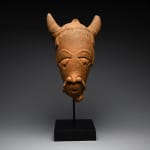Nok Terracotta Horned Head, 500 BCE - 500 CE
Terracotta
39.4 x 23.5 cm
15 1/2 x 9 1/4 in
15 1/2 x 9 1/4 in
PF.5499
Further images
The first Nok terracotta head was discovered in 1928. The Nok style, dating before the birth of Christ, is the earliest known example of terracotta African portraiture. The Nok figures...
The first Nok terracotta head was discovered in 1928. The Nok style, dating before the birth of Christ, is the earliest known example of terracotta African portraiture. The Nok figures are dramatic representations of important individuals. The creations of the Nok culture combine a great diversity in conceptual shape with a continuous unity of style that deems their artistry as unmistakable. The characteristic Nok style has left an indelible mark in the artistry of ancient Nigeria. Only recently have two new terracotta art forms been discovered further north of the Jos plateau: the Sokoto and the Katsina.
This sculpture captures an ancient personage from the Nok culture. Strikingly pronounced features augment his face. His wide set eyes have gazed upon sights we can only dream of, and his pronounced mouth have spoken powerful words and commands which many tribesmen have listened to in awe. His elongated face beholds his authority and command, and is struck in our minds indelibly. Helmets with horns have been noted through history in many varied cultures as a medium to the spiritual realm. We may be beholding here a shaman, high priest, king, or tribal leader of the early Nok culture who sought spiritual strength. His notability and significance within his tribe has been forever captured in the artistry of this momentous portrait.
This sculpture captures an ancient personage from the Nok culture. Strikingly pronounced features augment his face. His wide set eyes have gazed upon sights we can only dream of, and his pronounced mouth have spoken powerful words and commands which many tribesmen have listened to in awe. His elongated face beholds his authority and command, and is struck in our minds indelibly. Helmets with horns have been noted through history in many varied cultures as a medium to the spiritual realm. We may be beholding here a shaman, high priest, king, or tribal leader of the early Nok culture who sought spiritual strength. His notability and significance within his tribe has been forever captured in the artistry of this momentous portrait.
Literature
V27







